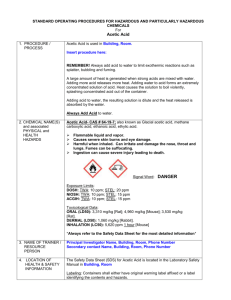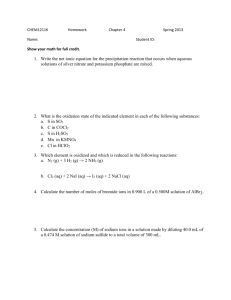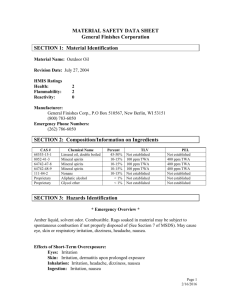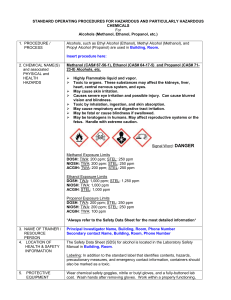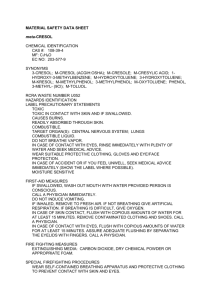Glacial acetic acid - Faculty of Electrical Engineering UiTM
advertisement
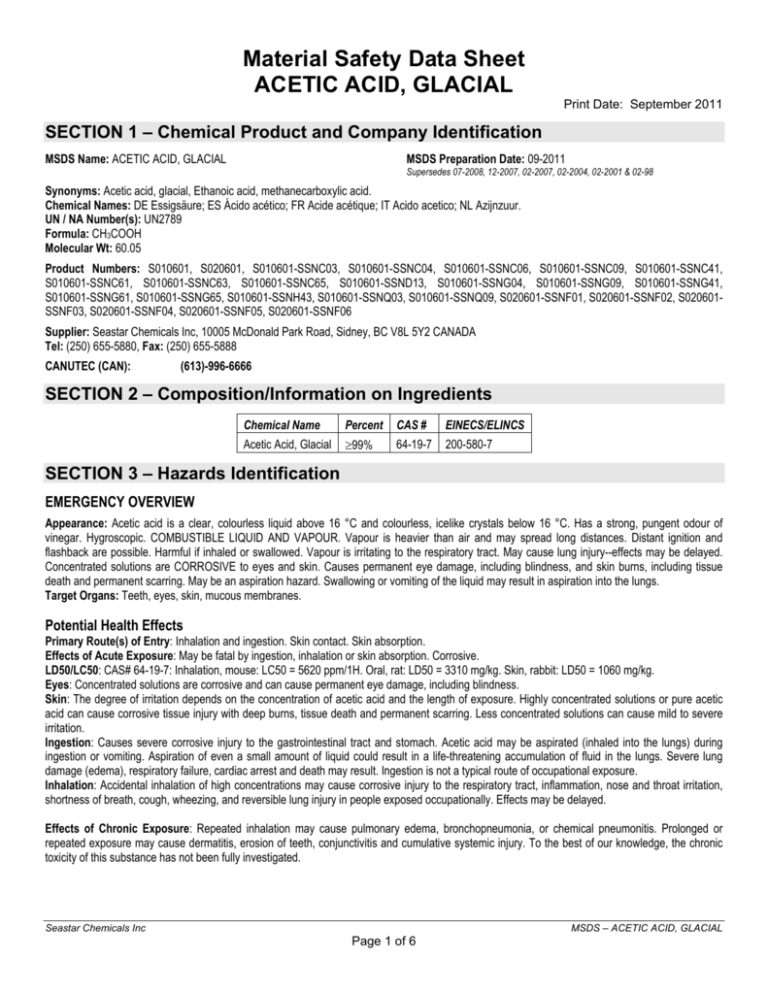
Material Safety Data Sheet ACETIC ACID, GLACIAL Print Date: September 2011 SECTION 1 – Chemical Product and Company Identification MSDS Name: ACETIC ACID, GLACIAL MSDS Preparation Date: 09-2011 Supersedes 07-2008, 12-2007, 02-2007, 02-2004, 02-2001 & 02-98 Synonyms: Acetic acid, glacial, Ethanoic acid, methanecarboxylic acid. Chemical Names: DE Essigsäure; ES Ácido acético; FR Acide acétique; IT Acido acetico; NL Azijnzuur. UN / NA Number(s): UN2789 Formula: CH3COOH Molecular Wt: 60.05 Product Numbers: S010601, S020601, S010601-SSNC03, S010601-SSNC04, S010601-SSNC06, S010601-SSNC09, S010601-SSNC41, S010601-SSNC61, S010601-SSNC63, S010601-SSNC65, S010601-SSND13, S010601-SSNG04, S010601-SSNG09, S010601-SSNG41, S010601-SSNG61, S010601-SSNG65, S010601-SSNH43, S010601-SSNQ03, S010601-SSNQ09, S020601-SSNF01, S020601-SSNF02, S020601SSNF03, S020601-SSNF04, S020601-SSNF05, S020601-SSNF06 Supplier: Seastar Chemicals Inc, 10005 McDonald Park Road, Sidney, BC V8L 5Y2 CANADA Tel: (250) 655-5880, Fax: (250) 655-5888 CANUTEC (CAN): (613)-996-6666 SECTION 2 – Composition/Information on Ingredients Chemical Name Acetic Acid, Glacial Percent 99% CAS # 64-19-7 EINECS/ELINCS 200-580-7 SECTION 3 – Hazards Identification EMERGENCY OVERVIEW Appearance: Acetic acid is a clear, colourless liquid above 16 °C and colourless, icelike crystals below 16 °C. Has a strong, pungent odour of vinegar. Hygroscopic. COMBUSTIBLE LIQUID AND VAPOUR. Vapour is heavier than air and may spread long distances. Distant ignition and flashback are possible. Harmful if inhaled or swallowed. Vapour is irritating to the respiratory tract. May cause lung injury--effects may be delayed. Concentrated solutions are CORROSIVE to eyes and skin. Causes permanent eye damage, including blindness, and skin burns, including tissue death and permanent scarring. May be an aspiration hazard. Swallowing or vomiting of the liquid may result in aspiration into the lungs. Target Organs: Teeth, eyes, skin, mucous membranes. Potential Health Effects Primary Route(s) of Entry: Inhalation and ingestion. Skin contact. Skin absorption. Effects of Acute Exposure: May be fatal by ingestion, inhalation or skin absorption. Corrosive. LD50/LC50: CAS# 64-19-7: Inhalation, mouse: LC50 = 5620 ppm/1H. Oral, rat: LD50 = 3310 mg/kg. Skin, rabbit: LD50 = 1060 mg/kg. Eyes: Concentrated solutions are corrosive and can cause permanent eye damage, including blindness. Skin: The degree of irritation depends on the concentration of acetic acid and the length of exposure. Highly concentrated solutions or pure acetic acid can cause corrosive tissue injury with deep burns, tissue death and permanent scarring. Less concentrated solutions can cause mild to severe irritation. Ingestion: Causes severe corrosive injury to the gastrointestinal tract and stomach. Acetic acid may be aspirated (inhaled into the lungs) during ingestion or vomiting. Aspiration of even a small amount of liquid could result in a life-threatening accumulation of fluid in the lungs. Severe lung damage (edema), respiratory failure, cardiac arrest and death may result. Ingestion is not a typical route of occupational exposure. Inhalation: Accidental inhalation of high concentrations may cause corrosive injury to the respiratory tract, inflammation, nose and throat irritation, shortness of breath, cough, wheezing, and reversible lung injury in people exposed occupationally. Effects may be delayed. Effects of Chronic Exposure: Repeated inhalation may cause pulmonary edema, bronchopneumonia, or chemical pneumonitis. Prolonged or repeated exposure may cause dermatitis, erosion of teeth, conjunctivitis and cumulative systemic injury. To the best of our knowledge, the chronic toxicity of this substance has not been fully investigated. Seastar Chemicals Inc MSDS – ACETIC ACID, GLACIAL Page 1 of 6 SECTION 4 – First Aid Measures Eyes: Flush skin and eyes with copious amounts of water for at least 20-30 minutes, holding lids apart to ensure flushing of the entire surface. Contact with liquid or vapor causes severe burns and possible irreversible eye damage. Get medical aid immediately. Skin: Get medical aid immediately. Immediately flush skin with plenty of soap and water for at least 20-30 minutes while removing contaminated clothing and shoes. Wash clothes before reuse. Discard shoes. Ingestion: Do NOT induce vomiting. If victim is conscious and alert, give 2-4 cupfuls of milk or water. Consult a physician immediately. Never give anything by mouth to an unconscious person. Keep patient warm and quiet. Inhalation: Get medical aid immediately. Remove patient from exposure to fresh air immediately. Administer approved oxygen supply if breathing is difficult. Administer artificial respiration or CPR if breathing has ceased. Call a physician. Symptoms of pulmonary edema can be delayed up to 48 hours after exposure. Notes to Physician: Treat symptomatically and supportively. Consult a doctor and/or the nearest Poison Control Centre for all exposures except minor instance of inhalation or skin contact. Antidote: No specific antidote exists. SECTION 5 – Fire Fighting Measures General Information: COMBUSTIBLE LIQUID AND VAPOUR. Can form explosive mixtures with air at, or above, 39 °C. Vapour is heavier than air and may travel a considerable distance to a source of ignition and flash back to a leak or open container. Vapours from warm liquid can accumulate in confined spaces, resulting in a flammability and toxicity hazard. Closed containers may rupture violently when heated. NOTE: The fire properties of acetic acid depend upon the strength of the solution. In concentrated form, its properties approach those of glacial acetic acid. Reacts with most metals to form highly flammable hydrogen gas, which can form explosive mixtures with air. Firefighters should wear a positive pressure selfcontained respirator (SCBA) and full-body encapsulating chemical protective suit. Extinguishing Media: For small fires, use dry chemical, carbon dioxide, water spray or alcohol-resistant foam. Use water spray to cool fire-exposed containers or disperse vapours if they have not ignited. Auto-ignition Temperature: 867-869 °F (463-465 °C); also reported as 516 °F (961 °C) Flash Point: 39-43 °F (103-109 °C) (closed cup) NFPA Rating: Health 3; Flammability 2; Instability 0. Explosion Limits: Lower: 4% (also reported as 5.3-5.4%); Upper: 16% (also reported as 19.9%). Special Fire and Explosion Hazards: Flash back along vapour trail may occur; eliminate sources of ignition. Emits toxic fumes under fire conditions. Empty container may contain explosive or flammable residue. Hazardous combustion products – Oxides of carbon. SECTION 6 – Accidental Release Measures General Information: Use proper personal protective equipment as indicated in Section 8. Spills/Leaks: Restrict access to area until completion of clean-up. Ensure clean-up is conducted by trained personnel only. Use water spray to dilute spill to a non-flammable mixture. Avoid run-off into storm sewers and ditches which lead to waterways. Extinguish or remove all ignition sources. Provide ventilation. Do not touch spilled material. Contain spill with earth, sand, or absorbent material which does not react with spilled material. Remove liquid by pumps or vacuum equipment. Place in suitable, covered, labelled containers. Steps to be taken in case material is released or spilled: Evacuate. Shut off all sources of ignition. Soak up spill with absorbent material which does not react with spilled chemical. Put material in suitable, covered, labelled containers. Flush area with water. Contaminated absorbent material may pose the same hazards as the spilled product. Waste disposal method: Burn in a chemical incinerator equipped with an after burner and scrubber. According to all applicable regulations. Avoid run-off. SECTION 7 – Handling and Storage Handling: This material is a CORROSIVE, COMBUSTIBLE LIQUID. Inspect containers for damage or leaks before handling. Immediately report leaks, spills or failures of the engineering controls. Avoid all ignition sources. Use in the smallest possible amounts, in a well-ventilated area, separate from the storage area. Avoid generating vapours or mists. Prevent the release of vapours or mists into the air. Do not use with incompatible materials. See Section 10 for more information. Never return contaminated material to its original container. Keep containers tightly closed when not in use. Empty containers may contain hazardous residues. Never add water to a corrosive. Always add corrosives to COLD water. When mixing with water, stir small amounts in slowly. Never perform any welding, cutting, soldering, drilling or other hot work on an empty vessel, containers or piping until all liquid and vapours have been cleared. Storage: Store in a cool, dry, well-ventilated area, out of direct sunlight and away from heat and ignition sources. Store away from oxidizers and corrosives and other incompatible materials such as most common metals. See Section 10 for more information. Inspect all incoming containers to make sure they are properly labelled and not damaged. Keep quantity stored as small as possible. Keep containers tightly closed. Empty containers may contain hazardous residues. Have appropriate fire extinguishers and spill clean-up equipment in or near storage area. Seastar Chemicals Inc MSDS – ACETIC ACID, GLACIAL Page 2 of 6 SECTION 8 – Exposure Control/Personal Protection Engineering Controls: Use adequate general or local exhaust ventilation to keep airborne concentrations below the permissible exposure limits. Exposure Limits: Chemical Name Acetic acid, glacial ACGIH 10 ppm TWA (25 mg/m3 TWA); 15 ppm STEL (37 mg/m3 STEL) NIOSH 10 ppm TWA (25 mg/m3 TWA); 15 ppm STEL (37 mg/m3 STEL); 50 ppm IDLH OSHA 10 ppm TWA (25 mg/m3 TWA) OSHA Vacated PELs Acetic acid: 10 ppm TWA; 25 mg/m3 TWA. Personal Protective Equipment Eyes: Wear appropriate protective eyeglasses or chemical safety goggles as described by OSHA’s eye and face protection regulations in 29 CFR 1910.133. Skin: Wear appropriate protective neoprene or polyethylene gloves to prevent skin exposure. Apron or clothing sufficient to protect skin. Clothing: Wear appropriate protective clothing to prevent skin exposure. Neoprene, PVC or polyethylene apron or clothing sufficient to protect skin. Respiratory Protection: Follow the OSHA respirator regulations found in 29CFR 1910.134. Always use a NIOSH-approved respirator when necessary. Wear appropriate OSHA/MSHA approved chemical cartridge respirator. If more than TLV, do not breathe vapour. Wear self-contained breathing apparatus. Ventilation: Use only in a chemical fume hood. Adequate ventilation to maintain vapour/dust below TLV. Other Protective Equipment: Make eye bath and emergency shower available. SECTION 9 – Physical and Chemical Properties Physical State: Liquid Appearance: Colourless Odour: Pungent odour – acetic odour (vinegar-like) pH: 2.4 (1 M solution in water) Vapour Pressure: 1.52 kPa (11.4 mm Hg) @ 20 °C Vapour Density: 2.07 (air = 1) Evaporation Rate: 0.97 (n-Butyl acetate = 1) Viscosity-Dynamic: 1.22 mPa.s (100% w/w), 2.39 mPa.s (90% w/w) @ 20 °C. Boiling Point: 100% (w/w): 117.87 °C (244.2 °F) Freezing/Melting Point: 100% (w/w): 16.635 °C (61.9 °F); 80.6% (w/w): -7.4 °C (18.7 °F) Decomposition Temperature: No information available. Solubility: Soluble in all proportions in water, ethanol, acetone, diethyl ether, glycerol and benzene. Specific Gravity/Density: 100% (w/w): 1.0495 @ 20 °C; 80% (w/w): 1.08 @ 15 °C Molecular Formula: C2H4O2 Molecular Weight: 60.0268 SECTION 10 – Stability and Reactivity Chemical Stability: Stable at room temperature in closed containers under normal storage and handling conditions. Conditions to Avoid: Incompatible materials, ignition sources, sparks or flame, excess heat. Incompatibilities with Other Materials: Reacts with most common metals to produce hydrogen. Oxidizing agents, acids, alcohols, alkalies, amines, peroxides. Acetaldehyde, 2-aminoethanol, ammonium nitrate, bromine pentafluoride, chlorine trifluoride, chlorosulfonic acid, chromic acid, chronic anhydride + acetic anhydride, diallyl methyl carbinol + ozone, ethylene diamine, ethyleneimine, hydrogen peroxide, nitric acid, nitric acid + acetone, oleum, perchloric acid, permanganates, phosphorus isocyanate, phosphorus trichloride, potassium hydroxide, potassium-t-butoxide, sodium hydroxide, sodium peroxide, and xylene. See NFPA Fire Protection Guide for specifics. Hazardous Decomposition Products: Carbon monoxide, carbon dioxide. Hazardous Polymerization: Has not been reported. Reaction Product(s): Contact with incompatible materials may cause explosion or fire. SECTION 11 – Toxicological Information RTECS: CAS# 64-19-7: AF1225000. LD50/LC50: CAS# 64-19-7: Inhalation, mouse: LC50 = 5620 ppm/1H. Oral, rat: LD50 = 3310 mg/kg. Skin, rabbit: LD50 = 1060 mg/kg. Carcinogenicity: CAS# 64-19-7: Not listed as carcinogen by ACGIH, IARC, NIOSH, NTP, OSHA, or CA Prop 65. Epidemiology: Standard Draize test: Skin, human – 50 mg/24H, mild reaction. Teratogenicity: Effects of Newborn: behavioral, Oral-rat TDLo = 700 mg/kg. Reproductive: Fertility: male index, itt-rat TDLo = 400 mg/kg. Mutagenicity: There have been no positive reports once the effect of pH on culture media has been controlled. Neurotoxicity: No information available. SECTION 12 – Ecological Information Ecotoxicity: Bluegill (fresh water) TLm = 75 ppm/96H. Goldfish (fresh water) TLm = 100 ppm/96H. Shrimp (aerated water) LC50 = 100-330 ppm/48H. Physical: No information available. Other: None. Seastar Chemicals Inc Environmental: Substance spreads on soil surface and penetrates at rate dependent on soil type and water content. Substance readily degrades in water and shows little potential for bioaccumulation. MSDS – ACETIC ACID, GLACIAL Page 3 of 6 SECTION 13 – Disposal Considerations Dispose of in a manner consistent with federal, provincial/state/territorial, and local regulations. RCRA D-Maximum Concentration of Contaminants: None of the components are on this list. RCRA D Series – Chronic Toxicity Reference Levels: None of the components are on this list. RCRA F Series Wastes: None of the components are on this list. RCRA P Series Wastes: None of the components are on this list. RCRA U Series Wastes: None of the components are on this list. RCRA Substances Banned from Land Disposal: None of the components are on this list. SECTION 14 – Transport Information CANADIAN TRANSPORTATION OF DANGEROUS GOODS (TDG) SHIPPING INFORMATION Shipping Name and Description: ACETIC ACID, GLACIAL; or ACETIC ACID SOLUTION, more than 80 per cent acid, by mass UN Number: UN2789 Class: 8, 3 Packing Group/Category: II Special Provisions: --Marine Pollutant: --Passenger Carrying Road/Railway Vehicle Index: 1 kg or L NOTE: This information incorporates the Transportation of Dangerous Goods Regulations SOR/2001-286, effective October 14, 2009. US DEPARTMENT OF TRANSPORT (DOT) HAZARDOUS MATERIALS SHIPPING INFORMATION (49 CFR) Shipping Name and Description: ACETIC ACID, GLACIAL or ACETIC ACID SOLUTION, with more than 80 percent acid, by mass Identification Number: UN2789 Hazard Class or Division: 8 Packing Group: II NOTE: This information was taken from the US Code of Federal Regulations Title 49 - Transportation and is effective July 1, 2009. IATA (1 January – 31 December 2010) UN/ID No. A Proper Shipping Name / Description B Class or Div. (Sub Risk) C 2789 Acetic acid, glacial 8 (3) Hazard Label(s) D PG E Passenger and Cargo Aircraft Pkg Max Net Inst Qty/Pkg I J Corrosive & II 809 Flamm. liquid NOTE: Consult IATA DG Regulations for the most recent information, abbreviations and reference marks. 1L Cargo Aircraft Only Pkg Max/Net Inst Qty/Pkg K L 813 S.P. See 4.4 M 30 L SECTION 15 – Regulatory Information US OCCUPATIONAL SAFETY AND HEALTH ADMINISTRATION (OSHA) HAZARD COMMUNICATION STANDARD (29 CFR 1910.1200) OSHA Hazard Communication Evaluation: Meets criteria for hazardous material, as defined by 29 CFR 1910.1200. US Federal TSCA: CAS# 64-19-7 is listed on the TSCA Inventory. Health and Safety Reporting List: None of the components are on this list. Chemical Test Rules: None of the components are on this list. TSCA Section 12b: None of the components are on this list. TSCA Significant New Use Rule (SNUR): None of the components are on this list. CERCLA Reportable Quantities (RQ): CAS# 64-19-7: final RQ = 5000 pounds (2270 kg). SARA Threshold Planning Quantities (TPQ): None of the components are on this list. SARA Hazard Categories: CAS# 64-19-7: Acute, chronic, flammable. SARA Section 313: None of the components are on this list. Clean Air Act – Hazardous Air Pollutants (HAPs): None of the components are on this list. Clean Air Act – Class 1 Ozone Depletors: None of the components are on this list. Clean Air Act – Class 2 Ozone Depletors: None of the components are on this list. Clean Water Act – Hazardous Substances: CAS# 64-19-7 is listed as a Hazardous Substance under the CWA. Clean Water Act – Priority Pollutants: None of the components are on this list. Clean Water Act – Toxic Pollutants: None of the components are on this list. OSHA – Highly Hazardous: None of the components are on this list. US State State Right to Know: Acetic acid can be found on the following state Rightto-Know lists: California, New Jersey (RTK# 0004), Florida, Pennsylvania, Minnesota, Massachusetts (100 lbs RQ). California Prop 65: No information available. California No Significant Risk Level: No information available. CANADIAN WORKPLACE HAZARDOUS MATERIALS INFORMATION SYSTEM (WHMIS) CCOHS WHMIS Classification: B3 - Flammable and combustible material - Combustible liquid. E - Corrosive material. Seastar Chemicals Inc MSDS – ACETIC ACID, GLACIAL Page 4 of 6 WHMIS Health Effects Criteria Met by this Chemical: E - TDG class 8 - corrosive substance WHMIS Ingredient Disclosure List: Included for disclosure at 1% or greater. Detailed WHMIS Classification According to Criteria: Class A - Compressed Gas: Does not meet criteria. Class B - Flammable and Combustible Material: Meets criteria for "Combustible liquid". Closed cup flash point: 39 °C. Class C - Oxidizing Material: Does not meet criteria. Class D - Poisonous and Infectious Material. Division 1 - Immediate and Serious Toxic Effects: Does not meet criteria. Acute Lethality: Does not meet criteria. LC50 (mouse): 2810 ppm (4-hour exposure); LD50 (oral, rat): 3530 mg/kg; LD50 (dermal, guinea pig): 3300 mg/kg (28% solution) (unconfirmed). Class D - Poisonous and Infectious Material. Division 2 - Other Toxic Effects: Does not meet criteria. See detailed evaluation below. Chronic Health Effects: Insufficient information. Carcinogenicity: Does not meet criteria. Not included in standard reference lists. Teratogenicity and Embryotoxicity: Insufficient information. Reproductive Toxicity: Insufficient information. Mutagenicity: Insufficient information. No in vivo studies located. Respiratory Tract Sensitization: Does not meet criteria. Not reported as human respiratory sensitizer. Skin Irritation: Corrosive materials are not also classified as irritants. Eye Irritation: Corrosive materials are not also classified as irritants. Skin Sensitization: Insufficient information. One case report of occupational skin sensitization to acetic acid. Class E - Corrosive Material: Meets criteria. TDG Class 8; concentrated solutions are corrosive to eyes and skin. All concentrations of acetic acid are corrosive to type 1020 carbon steel up to 240 °C (115.6 °F). Very high concentrations are not corrosive to aluminum alloys (not specified). Water increases the corrosion rate of aluminum significantly. No information for type 7075-T6 aluminum was located. Class F - Dangerously Reactive Material: Does not meet criteria. Canadian DSL/NDSL: CAS# 64-19-7 is listed on Canada’s DSL/NDSL List. EUROPEAN UNION (EU) CLASSIFICATION AND LABELLING INFORMATION EU Index#: EU Signal Word: EU Classification: 607-002-00-6 Danger Skin corrosion – Category 1A Flammable liquid – Category 3 EU Hazard Statements: H226: Flammable liquid and vapour. H314: Causes severe skin burns and eye damage. EU Precautionary Statements: P210: Keep away from heat/sparks/open flames/hot surfaces. – No smoking. P233: Keep container tightly closed. P240: Ground/bond container and receiving equipment. P241: Use explosion-proof electrical/ventilating/lighting/equipment. P242: Use only non-sparking tools. P243: Take precautionary measures against static discharge. P260: Do not breathe dust/fume/gas/mist/vapours/spray. P264: Wash thoroughly after handling. P280: Wear protective gloves/protective clothing/eye protection/face protection. P301+P330+P331: IF SWALLOWED: Rinse mouth. Do NOT induce vomiting. P303+P361+P353: IF ON SKIN (or hair): Remove/Take off immediately all contaminated clothing. Rinse skin with water/shower. P304+P340: IF INHALED: Remove victim to fresh air and keep at rest in a Exposure Limits CAS# 64-19-7: OEL-AUSTRALIA: TWA 10 ppm (25 mg/m3); STEL 15 ppm (37 mg/m3) OEL-BELGIUM: TWA 10 ppm (25 mg/m3); STEL 15 ppm (38 mg/m3) OEL-DENMARK: TWA 10 ppm (25 mg/m3) OEL-FINLAND: TWA 5 ppm (13 mg/m3); STEL 10 ppm (25 mg/m3) OEL-FRANCE: VLE 10 ppm (25 mg/m3) OEL-HUNGARY: TWA 25 mg/m3; STEL 25 mg/m3 OEL-JAPAN: TWA 10 ppm (25 mg/m3) OEL-KOREA: TWA 10 ppm (25 mg/m3); STEL 15 ppm (37 mg/m3) OEL-MEXICO: TWA 10 ppm (25 mg/m3); STEL 15 ppm (37 mg/m3) OEL-NETHERLANDS: MAC-TGG 25 mg/m3 OEL-NEW ZELAND: TWA 10 ppm (25 mg/m3); STEL 15 ppm (37 mg/m3) EU Pictograms: GHS05 GHS02 position comfortable for breathing. P305+P351+P338: IF IN EYES: Rinse cautiously with water for several minutes. Remove contact lenses, if present and easy to do. Continue rinsing. P370+P378: In case of fire: Use dry chemical, carbon dioxide, or alcoholresistant foam for extinction. Use water spray ONLY to cool fire-exposed containers or disperse vapours if they have not ignited. P310: Immediately call a POISON CENTER or doctor/physician. P321: Specific treatment (see P310). P363: Wash contaminated clothing before reuse. P403+P233: Store in a well-ventilated place. Keep cool. P405: Store locked up. P501: Dispose of contents/container according to federal, regional and local government requirements. OEL-NORWAY: TWA 10 ppm (25 mg/m3) OEL-THE PHILIPPINES: TWA 10 ppm (25 mg/m3) OEL-POLAND: TWA 5 mg/m3; STEL 35 mg/m3 OEL-RUSSIA: STEL 5 mg/m3; Skin OEL-SWEDEN: TWA 5 ppm (13 mg/m3); STEL 10 ppm (25 mg/m3) OEL-SWITZERLAND: MAC-W 10 ppm (25 mg/m3); KZG-W 20 ppm (50 mg/m3) OEL-THAILAND: TWA 10 ppm (25 mg/m3) OEL-TURKEY: TWA 10 ppm (25 mg/m3) OEL IN ARGENTINA, BULGARIA, COLOMBIA, JORDAN check ACGIH TLV OEL IN SINGAPORE, VIETNAM check ACGIH TLV Seastar Chemicals Inc MSDS – ACETIC ACID, GLACIAL Page 5 of 6 SECTION 16 – Other Information The statements contained herein are offered for informational purposes only and are based upon technical data. Seastar Chemicals Inc believes them to be accurate but does not purport to be all-inclusive. The above-stated product is intended for use only by persons having the necessary technical skills and facilities for handling the product at their discretion and risk. Since conditions and manner of use are outside our control, we (Seastar Chemicals Inc) make no warranty of merchantability or any such warranty, express or implied with respect to information and we assume no liability resulting from the above product or its use. Users should make their own investigations to determine suitability of information and product for their particular purposes. Seastar Chemicals Inc MSDS – ACETIC ACID, GLACIAL Page 6 of 6
